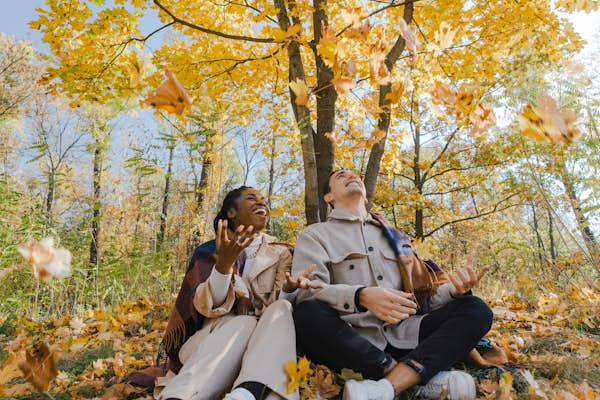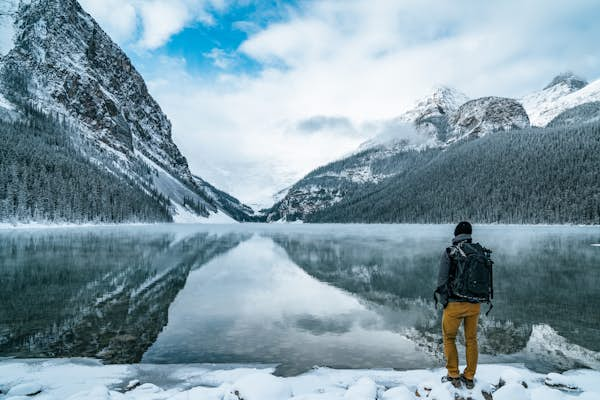
Best places to see fall colors in the US
It’s a universal truth: the turning of the fall foliage is one of the world’s most enchanting natural phenomena, and in the US, it comes in many different iterations.
You can drive beneath the amber canopies of New England, watch fiery maples take over the vistas of the northern midwest, or marvel at the golden aspens as they contrast against the rocky peaks of the west.
All that said, determining peak leaf peeping season isn’t an exact science – color windows vary across the country due to weather patterns, elevation, and sometimes just pure chance. Luckily for you, we’ve pulled together a list of our favorite fall destinations and tips on when to catch the colors at their brightest.

1. Stowe, Vermont
Perhaps the most famous US destination for autumn lovers, Stowe delivers on all counts: spectacular palettes of reds, oranges and yellows; tons of mountain roads and hikes; and access to the highest points in Vermont’s photogenic Green Mountains. Rent a cabin or pitch a tent among some of New England’s most gorgeous forests and enjoy the scenery this region is renowned for.
Stowe’s fall foliage season generally lasts from early September through late October, with colors peaking in the middle of that period. Use Stowe’s Foliage Finder to follow the color progression on the area’s various scenic drives.
Planning tip: Looking for a place to stay? The 120-acre Topnotch Resort, nestled at the foot on Mount Mansfield, features a spa and fitness center, tennis academy, fly fishing on the Lamoille River and equestrian center.

2. Shenandoah National Park, Virginia
This expansive park encompasses nearly 100 miles of central Appalachian views, making it one of the most accessible – and scenic – fall destinations in the eastern US. Drive along the famous Skyline Drive for breathtaking autumnal vistas or take to the trails to wander beneath Virginia’s beautiful deciduous forests as they don their most exuberant colors.
Shenandoah’s fall colors generally begin to emerge in October, peaking midway through the end of the month. The park posts weekly updates on the color changes to their social media accounts, but if you’re looking for a more robust tracker ahead of time, check out the Virginia Department of Forestry’s fall foliage reports.
3. Columbia River Gorge, Oregon
Imagine a large, mirror-like river buttressed by misty mountains and forested shores, all graced with explosions of gold and orange – a scene worthy of a painting. Happily, this place is real and it exists at the Columbia River Gorge National Scenic Area in Oregon, one of the best leaf-peeping destinations on the west coast.
Marvel at the intermingling of evergreen forests with alders and maples, all against a mountainous backdrop. Fall colors in this region of Oregon reach their zenith in late October.

4. Zion National Park, Utah
If you visit Zion in the fall, you’ll see a scene you likely won’t see anywhere else on earth: vermillion maples and yellow cottonwoods accenting the striking red rock desert. The park’s deciduous forests hug the creeks and rivers, and routes like the Emerald Pools Trail offer immersive journeys through Zion’s autumnal wonders.
Zion’s color-changing process varies depending on elevation in the park – higher elevations peak in mid-October, while lower elevations hold on to their colorful foliage as long as the middle of November.
Planning tip: Nestled on the north fork of the Virgin River Springdale, just 1.4 miles from the park, is a great place to set up base camp for those not staying at Zion. With its backdrop of red rocks, it’s fun to explore shops and galleries like Bumbleberry Gifts, where you can try the bumbleberry pie, and DeZion Gallery, which features the works of local and regional artists.
5. Tennessee/North Carolina state line
The Tennessee/North Carolina state line is a marvelous region to visit year round, but it takes on a special charm in the fall, when the mountain forests shed the green for a warmer set of hues. Hike through the Pisgah and Cherokee National Forests, get a birds-eye-view of golden valley floors at Roan Mountain, or dig deep into the beauty of southern Appalachia at Great Smoky Mountains National Park.
Like its western counterparts, Southern Appalachia’s fall colors are elevation dependent. The region’s higher reaches develop colors in early and mid-October, while lower elevations reach their color peaks in late October and early November.

6. West Virginia
Perhaps one of the country’s most unsung – but most beautiful – destinations, West Virginia is a fall foliage fan’s dream. Covered in forests that wrap across the state’s undulating terrain, West Virginia offers an alternative leaf peeping experience that rivals some of the country’s most famous fall color destinations. Watch the colors collide with the waterfalls and craggy peaks of the Potomac Highlands, take in views of crimson and tangerine tree tops along one of the continent’s oldest rivers (ironically named the New River), or hike into the multi-hued hollows of the Hatfield McCoy Mountains.
Leaves begin changing in late September, with peak colors appearing in mid-October; West Virginia tourism manages a live leaf map throughout the fall, so you can see the changes as they happen.
7. Northwestern Wyoming
Wyoming’s mountainous west knows how to deliver drama, and the region takes things up a notch in the fall. Aspens, cottonwoods, willows, and black hawthorns drape the landscape in color, a striking foreground to the imposing Tetons and the winding Snake River. Yellowstone gets in the spirit, too, and don’t miss the opportunity to immerse yourself in the area’s national forests. If you’re lucky, you may even get a light dusting of snow, which really sets the fall colors off.
Colors peak in the Wyoming mountains from late September to early October, with colors changing earlier at higher elevations.
8. Wisconsin Northwoods
Home to sprawling boreal forests and glacial lakes, the Wisconsin Northwoods immerse visitors in true autumn glory. Take a scenic drive through the Chequamegon-Nicolet National Forest, fish for trophy musky beneath the multihued canopy, or visit one of the region’s small communities for fall festivals.
The fall foliage in northern Wisconsin begins its transformation in September, with colors maxing out in early October. Follow Travel Wisconsin’s fall color reports for live updates.
Detour: It’s a little over two hours away, but Door County, a peninsula bordered by Lake Michigan on one side and Green Bay on the other, is a spectacular fall foliage destination. Its scenic drives meander through a landscape of rolling hills, apple orchards, and such adorable small towns as Fish Creek and Egg Harbor. The area is known for its artist galleries, wineries, breweries, and distilleries as well as cheese. Peak fall color season is late September to mid-October.

9. Northern Nevada
Nevada may be well known for its deserts, but its mountainous north provides an oasis of fall foliage that just may surprise you. Head to Lamoille Canyon in the Ruby Mountains to see golden treetops wrap around the region’s rocky peaks, and if you’re feeling adventurous, don a backpack and immerse yourself in nature on the Ruby Crest Trail.
Fall colors emerge in mountainous Northern Nevada in October, usually reaching their most colorful state at the end of the month.
10. Ozark Highlands Scenic Byway, Arkansas
This 35-mile route crosses the Boston Mountain Range of the Ozarks in Arkansas, taking you through two national forests (Ozark and Ouachita), across the 165-mile Ozark Highlands Trail, and up to Buffalo National River, the country’s first. A joyous network of twists and turns through the state’s most lush countryside, this byway delivers autumn foliage in high definition.
Like other destinations in this part of the country, the Ozarks start seeing fall colors in late September or early October, with things peaking in late October and early November.
11. Tunnel of Trees, Northern Michigan
Considered one of the most scenic drives in the United States, the 20-mile stretch of M-119 winds its way along Lake Michigan under a canopy of treetops, giving the road the nickname of Tunnel of Trees. Pretty any time of the year, the two-lane road is spectacular in the fall when the leaves are a blaze of red, orange and yellow.
Following the crest of a bluff overlooking the blue waters of Lake Michigan, at times it’s possible to catch a glimpse of Beaver and Isle Aux Galets, two nearby islands. Designated as a Scenic Heritage Road, M-119 is also a trip through history. Originally used as a north/south trail by Native Americans, the road going north begins in historic Harbor Springs. Located on Little Traverse Bay, the town is a gem of lovely Victorian and Queen Anne homes and a downtown filled with boutiques, art galleries and restaurants.
Peak fall color season is typically the last week of September and the first two weeks of October.
Planning tip: Along the way, stop for ice cream and a look around the general store in Good Hart, which first opened its doors in 1934. Then continue to Cross Village and the legendary (at least to Michiganders) Leggs Inn.
12. Catskill Mountains, New York
With its gorges and soaring peaks, vast vistas, lakes and the Hudson River, the Catskill Mountains has been a popular destination since the 1800s. That’s when its beauty, captured by such Hudson River School painters as Thomas Cole and Frederic Church, inspired city dwellers along the Eastern Seaboard to make their way there. Follow the Hudson River School Trail to learn more about these artists. Among the 21 stops are the Thomas Cole National Historic Site in the village of Catskill and the Hudson River from the Vanderbilt Mansion National Historic Site.
Stroll across the Hudson River Skywalk connecting Cole’s home to Frederic Church’s Olana, its fantastic architecture inspired by the artist’s time in Persia. Explore such natural wonders as Kaaterskill Falls. It’s New York’s highest waterfall–260ft compared to Niagara’s 167ft.
Though the time varies according to elevation and weather, typically fall colors in the Catskills begin in late September and peak around the second week in October.
13. Covered bridges, Parke County, Indiana
Travel along scenic drives lined with leaves displaying their vibrant fall colors on a trip to the past in Parke County, Indiana. There are 31 wood-covered bridges here, the oldest dating back to 1856, in what locals call “The Covered Bridge Capital of the World.” Though they were designed for horse and buggies, the majority carry cars over waterways such as Raccoon and Sugar Creeks.
As an added plus, Parke County has two working grist mills. The picturesque red mill in Bridgeton is next to the Bridgeton Covered Bridge that spans a 200ft long waterfall. The other, in the tiny town of Mansfield, is open only for festivals, including the 10-day Parke County Covered Bridge Festival that starts on the second Friday of October.
The timing is perfect as that’s when the fall colors peak and it’s also when this very rural county comes to life. Download the map and choose where to go.
Planning tip: The festival attracts over two million people so expect delays and crowded roads. Or, go just before or after. You’ll still get a lot of colors though you’ll miss the events but also the crowds.
Frequently Asked Questions
Which US state has the best fall foliage?
New York State typically ranks highest for fall colors often followed by other Eastern Seaboard states such as Vermont. Others frequently listed include Oregon, Utah, Wisconsin, and Michigan.
What are the best weeks for fall foliage?
Depending upon the location and elevations, fall colors can begin as early as mid-September all the way and continue on through early November.
What state has the longest fall foliage?
Connecticut, Vermont, Virginia, West Virginia, Missouri and New York are among the top states for the longest fall foliage.
You May Also Like

June 2024 Horoscopes — What’s In Store For Each Sign?
March 21, 2024
4 Korean Oil Cleansers for Double Cleansing
January 22, 2023

